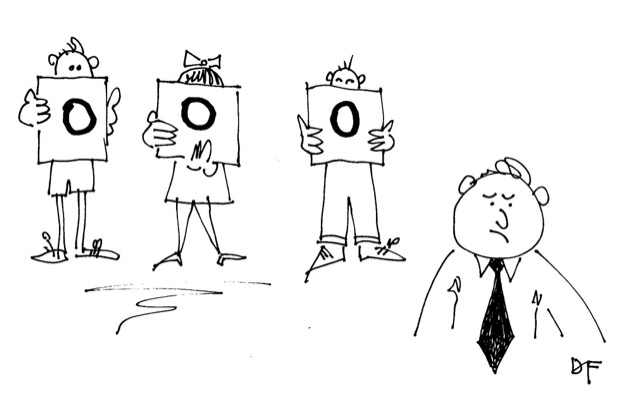
GUEST POST from Rachel Audige
While it dates back to the 1970s, the expression ‘think outside the box’ is still in vogue. Yet the idea of creativity being best when unrestrained is at best a bit of a fable and at worst, unhelpful – particularly when we are confined to the four walls of our home! What is really helpful is when people actually impose constraints on their thinking. It’s counter-intuitive but creativity loves constraints.
So, what sort of constraints does it love? In my experience, there are five. The first — contrary to popular belief — is to artificially create a frame or a ‘box’. In her inspiring TEDx talk at Newark Academy, Tess Callahan spoke about “the love affair between creativity and constraint.” We all admire people who think outside the box but how do they do it? What if the key to thinking ‘outside the box’ is to create a box to think outside of?”, she says.
For many, thinking ‘outside the box’ means exploring new paths and “being open-minded” and “brainstorming without judgement”. This makes sense but how to do this is not very clear. Subject to the rigour of the facilitator, brainstorming sessions are likely to generate a huge list of ideas that are more or less out of reach. I call these ‘aromatherapy ideas’ (inspired by an ad where the brainstorm led to aromatherapy candles in the hire car putting everyone — even the driver! — to sleep). The team feels empowered and hyped but months later when nothing has happened to their ideas, they are cynical and will boot out the next person who wants to talk innovation.
In workshops we illustrate the difference between outside and inside-the-box thinking by asking people to go create a piece of exercise equipment that we’ve never seen before. Faces look blank, the buzz is low but the pairs come up with a few nice ideas. In a second round we ask them to do the same but to make it exercise equipment that we can use at the wheel of our car. The noise level trebles, ideas fuse and even those who had nothing have some interesting ideas (along with the odd aromatherapy one!). We then ask them ‘Which exercise was easier?’. 95% will say the second (there’s always an outlier or two…). Give people the context; the box. Zoom in and work from there. This gives people focus and avoids the blank canvas syndrome.
The second constraint loved by creativity is the natural corollary of the first: once you have a defined ‘box’, you should follow a path of most resistance and limit the resources you can use to ideate or create.
Systematic Inventive Thinking (SIT), the Israeli company and innovation method that I believe really enhances creative thinking (as opposed to simply providing a process) is grounded in this belief that constraints foster creativity. The founders were so convinced of this that they imposed an artificial constraint on the creative process so that you have to strive to only use resources that are inside what we call the ‘Closed World’. The key to this is being systematic about how you go through the ‘inventory’ of this closed world. If you’re not, your cognitive biases will blind you to some great ideas…
That brings us to the third idea: once you have limited your frame and your resources, creativity is enhanced by drawing on inspiration; on templates. These help bust these biases and take a different path through our minds. When artists want to paint, they often learn by copying the masters. Likewise, in creative thinking and innovation it is powerful to draw on the most inventive ideas. There are countless templates to draw from. Biomimicry is based on the templates tried and tested by Mother Nature. The Speedo swimsuits inspired by shark skin to reduce drag were banned in the Olympics were seen to be a nice example of this. TRIZ (the inspiration for SIT) covers 40 patterns that not only inspire but are said to serve as predictive models for future innovations…
In SIT we work with five inventive thinking tools that come from five patterns present in the 80% of the most inventive ideas (‘surprising for some but there is a sort of DNA to creative ideas). They include removing an essential component (like Apple did with the Shuffle) or dividing up a process or product and moving a component in time or space (like H&M did when they moved the step of paying from the end of the shopping process to the moment the decision is made in the fitting room). The brilliant thing is that these templates not only increase our chances of coming up with something exciting but they help bust the cognitive biases that may lead us to miss resources that are right under our nose.
The fourth constraint is to diligently follow a workflow. In design thinking we have learnt to start with our customers’ needs and pain points (the “function”) and develop a solution (the “form”) to fit. This has been a crucial shift that taught organisations to stop product push but what if we could learn another workflow? And what if this workflow could help us suspend our embedded thinking so that we can unearth more original ideas?
Back in the early 90’s, a group of psychologists made an interesting discovery. When it comes to creating, people are innately better at uncovering the potential benefits of a given form than creating a new form to satisfy a given need. Or, to put it differently, we struggle to come up with a solution to a problem more than a problem for a given solution. Those of us who work with this find that this “back-to-front” approach is great way to stop ourselves from default thinking and embedding the structures, functions and relationships that we are used to into the new idea.
In SIT we call this ‘Function Follows Form’ and the more strictly we apply this workflow constraint, the more impactful it is on our creative thinking. We start by defining the closed world and listing the resources we have available. We then apply a template (depending on the most likely cognitive fixedness). This manipulation leads to a ‘virtual’ process, product or ‘situation’. This is when our resistance is greatest and if we are not strict about limiting our thinking to this oddly manipulated virtual form, we are likely to reject it and possibly miss the opportunities it offers. Once we have visualised it and described how it could work, we then explore its desirability, feasibility and viability, make any necessary adaptations and then test the idea if it warrants it. It is invaluable to know how to think both form to function as well as function to form.
The last constraint is that of embracing unchosen limitations. Phil Hansen (TEDxKC) tells a beautiful story of how he harnessed the power of embracing a ‘shake’’ to create even more extraordinary art.
After years of painting with a method of tiny dots, Hansen developed a shake in the hand that made it impossible to paint as he was used to doing. His dots “had become tadpoles”. It was good for “shaking a can of paint” but for Phil it was “the destruction of his dream of becoming an artist.” He left art school and he left art.
This didn’t work for him, however, so, after a while, he went to see a neurologist who diagnosed him with permanent nerve damage. This wasn’t great. What was great though was what he said to him: “ Why don’t you just embrace the shake?”
So he went home and started making art with nothing but scribbles . He then limited himself to his feet. He then moved to wood… He moved to larger materials where his hand wouldn’t hurt. He started with a single way of painting and ended up with endless possibilities. “This was the first time that I encountered the idea that embracing limitation could actually drive creativity,” he says.
He finished up school and got a new job. This enabled him to afford more art supplies. He explains that he “went nuts” buying stuff and took it home with the intention to do something incredible. He sat there for hours and nothing came. Same thing the next day. And the next. He was “creatively blank”; paralysed by all these choices that he never had before. That was when he thought about what the neurologist had said…
He realised that if he ever wanted his creativity back, he had to quit trying so hard to think outside of the box, and “get back into it”. In fact, he started exploring the idea that he could get more creative by actually looking for limitations? “We need to first be limited in order to become limitless,” he says, very poignantly.
He took this approach to being ‘inside the box’ and did a series of artworks where he imposed tight constraints: he could only paint on his chest, or he could only create with karate chops or what if he created art to destroy after its creation (an image of Jimmy Hendricks made out of 7000 matches — crazy!), what if he used frozen wine…“What I thought would be the ultimate limitation turned out to be the ultimate liberation as each time I created the destruction brought me back to a place of neutrality where I felt fresh to start a new project,” he explains.
He found myself in a state of constant creation “coming up with more ideas than ever…”
We don’t all have the honed creative skills of my new artist friend or of the astonishing Phil Hansen but that’s all the more reason to boost our creative potential. As individuals and in organisations, we need learnable, robust, repeatable tools to be more skilled inventive thinkers — and to be able to harness this on demand. We need methods that impose limitations. So try getting back inside the box and embrace the constraints!
![]() Sign up here to get Human-Centered Change & Innovation Weekly delivered to your inbox every week.
Sign up here to get Human-Centered Change & Innovation Weekly delivered to your inbox every week.

